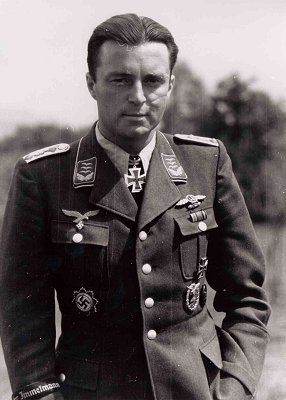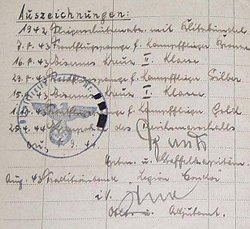
by François Saez, Paul Williams & Gordon Williamson
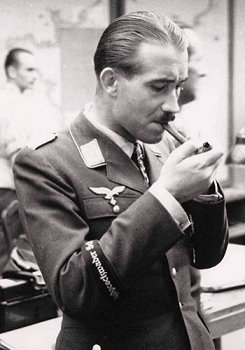
Introduction
Those cuffbands worn by units of the Luftwaffe between 1935 and1945 can be considered under three categories. Firstly, there are those which identified the wearer as having served in a particular formation and can be considered as commemorative pieces. Secondly, there are those which identify the wearer’s specific branch of the armed forces, and finally, the predominant type, those which identify the wearer’s current membership of a specific formation carrying a tradition or honor title. These latter units were usually regarded as elite formations.
All Luftwaffe cuffbands, with the exception of those worn by Fallschirmjäger units, were executed on a dark blue cloth base, whose texture and shade could vary considerably. The specified dimensions of a standard cuffband were 47cm (18 1/2 inches) in length and 3.3cm (1 1/3 inches) in width. Lettering in most cases was to be 1.9cm in height for upper case characters and 1cm for lower case characters, but variations exist.
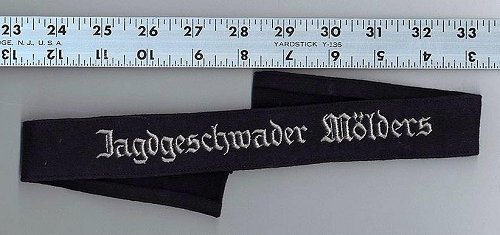
The material from which the base band was manufactured was generally dark blue wool or fine doeskin wool, but original examples are known on felt backing. The specified dark blue color could vary considerably in shade from a very dark almost blue-black shade to a deep royal blue. Fading could also exaggerate such differences in color.
The lettering on Luftwaffe cuftbands was machine-embroidered
fine silver-grey yarn for enlisted men and NCOs, though these lower ranks
were also permitted to purchase at their own expense, cuftbands in which
the lettering was executed in fine hand-embroidered matte-grey cording
of a much thicker type than used on the standard machine-embroidered pieces.
Machine- and hand-embroidered cuffbands .... enlisted men / NCO and officer styles:
The reverse face of the cuffband often featured
a layer of linen cloth to reinforce the embroidered area. Though not always
present in machine-embroidered cuffbands, this reinforcement is almost
invariably found with those cuffbands bearing hand-embroidered lettering.
Generally speaking, the excess material to the width of the band was hemmed
over on to the reverse face, and a line of machine-stitching runs along
the edge of the band.
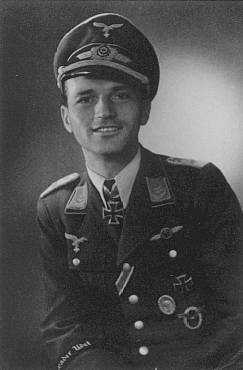 |
|
On 26 October 1944, Luftwaffen-Verordnungsblatt 44/1532, promulgated orders that in future, to avoid unnecessary waste of material, cuffbands were to be made to a standard length of just 22-25cm, thus saving on the material which would normally run out of sight around the back of the sleeve. It would seem, however, that considerable stocks of full length cuffbands were held so that few if any such shortened bands were ever issued. The wear of unit cuffbands by medical personnel, ordnance officers, officials, etc., who were attached to units entitled to wear cuffbands was prohibited on 26 July 1936 by Luftwaffen-Verordnungsblatt 36/985. Other specialist branches introduced after this date were also covered by this prohibition. This regulation was not, however, always adhered to.
|
|
|
A Luftwaffe Medical Officer
Dr. Gadermann not only served as Gruppenarzt III./Stuka-Geschw. 2 "Immelmann", but acted as Hans-Ulrich Rudel's radio operator/rear gunner following the death of Oberfeldwebel Erwin Hentschel - they were both together shot down five times! The "Stuka-Doktor" flew on around 850 missions.
Stabzarzt Gadermann was awarded the German Cross in Gold on 17.10.43 and the Ritterkreuz on 19.08.1944 |
A further order (Luftwaffen-Verordnungsbtatt 36/1065)
included even reserve officers of “Fliegendes Personal” (aircrews) in this
prohibition, though the prohibition on the wear of cuffbands by reserve
officers was rescinded when Luftwaffen- Verordnungsblatt 37/985 of 26 July
1937, in fact, required such reserve officers to wear the cuffband
of their base unit.
This prohibition was subsequently modified on
3 June 1942 by Luftwaffen-Verordnungsblatt 42/1519. It was accepted that
unit cuffbands could be awarded to specially deserving cases who had completed
a long period of attachment with a unit entitled to wear a cuffband. This
right was only valid so long as the individual remained with the unit.
Documentation
Luftwaffe personnel who were entitled to wear a unit cuffband were normally issued a Verleihungsurkunde (award document) and a paper authorizing its wear (Besitzeugnis). This was also usually listed in the holder’s Wehrpass and Soldbuch as part of their awards, and in their permanent file (Wehrstammbuch).
|
|
A Verleihungsurkunde for the Geschwader Boelcke cuff band awarded to Unteroffizier Hans Rummler, dated 1 August 1943. This "Geschwader Boelke" cuffband is of private-purchase quality. (Click on the image of the document for an expanded view) |
Click on the cuffband title for a full examination. Please note that in order to provide the reader with the very best detailed photographs, download times may be slow.
All text and pictures copyright François Saez, Paul Williams & Gordon Williamson. Layout Sebastian Bianchi
Thanks to:
- Stijn David
- "Rusfront collection"
- Sebastian Bianchi
- Saez François
- Peter v Lukacs
- Paul Williams
- Michael R. Heuer
- Mark Miller
-
Kevin Sienkiewicz
- Jacques CALERO
- Ian Jewison
- Gordon Williamson
- Gene Ashton
- Akira Takiguchi
- Ralf Abercrombie
- Chris Boonzaier
- Robert Noos
- George Petersen, National Capital Historical Sale
- Marc Van Velthoven
- Detlev Niemann
Top of Page 
© Copyright Wehrmacht-Awards.com LLC
